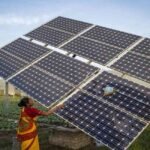Solar power is booming in India, and two popular solar panel types are monocrystalline and polycrystalline. Monocrystalline panels use a single high-purity silicon crystal and look uniform black. Polycrystalline panels are made by fusing many silicon fragments and have a blue-speckled appearance. Monocrystalline panels are usually more efficient, while polycrystalline panels are cheaper to make. Both types work well in India’s climate, but their differences affect efficiency, cost, and suitability. This article compares them on key factors (efficiency, cost, durability, looks, climate) and covers real Indian examples, government subsidies, and popular brands.
Differences in Appearance and Technology

- Monocrystalline (Mono) Panels: Made from one pure silicon crystal. They have a uniform dark black color and sometimes rounded cell corners. The single-crystal structure gives them higher efficiency. In production, a cylindrical silicon ingot is grown and then sliced into wafers.
- Polycrystalline (Poly) Panels: Made by melting together multiple silicon pieces. They have a blue, speckled look because of the multiple crystals. Manufacturing is simpler (casting molten silicon in a square mold), so poly panels cost less to produce. However, the crystal boundaries in poly panels slightly block electron flow, reducing efficiency compared to mono.
- In short, monocrystalline panels use one continuous crystal (more wasteful to make but very pure), while polycrystalline panels use many crystals (less waste but lower performance).
Efficiency and Performance
Monocrystalline panels are the most efficient among conventional silicon panels. Modern high-efficiency mono panels reach around 20–25% conversion efficiency. In 2025, top mono panels on the market exceed 22–24%. Polycrystalline panels are typically 15–18% efficient. For example, a good poly panel might be ~17% efficient, versus ~20% for a similar mono panel.
- Space and Output: Because mono panels are more efficient, you get more power per square foot. This is important for Indian homes with limited roof space. If space is tight, mono panels can produce the needed power with fewer panels.
- Performance in Heat: India’s hot summers can lower panel output. Monocrystalline panels have a lower temperature coefficient, so they lose less efficiency when hot. In other words, mono panels retain more of their power on a 45°C roof than poly panels do. This makes mono a slightly better choice in very hot climates.
- Cloudy/Low Light: On overcast or short winter days, mono panels also perform better. Their pure silicon and uniform structure capture diffuse light more effectively. Studies show monocrystalline panels produce more energy than polycrystalline in low-light conditions. (All panels do work on cloudy days, just at reduced output.)
- Warranty: Both types are very durable. Manufacturers typically offer 25-year performance warranties on mono and poly panels. Mono panels often boast lifespans up to 30–40 years, while poly panels are rated around 20–25 years. In practice, quality panels of either type will last over 25 years with minimal degradation.
Cost Comparison in India (2025)
In India, polycrystalline panels are generally cheaper upfront than monocrystalline ones. Current price ranges (2025) are roughly ₹28–38 per watt of capacity. Monocrystalline panels tend toward the higher end (e.g. ₹32–38/W) while polycrystalline panels are on the lower side (₹28–33/W). For example, a 300 W monocrystalline panel might cost about ₹9,600–₹11,400, whereas a similar poly panel might be around ₹8,400–₹9,900.
- Per-Panel Cost: Beyond per-watt, whole-panel prices vary by wattage. A typical 5 kW home system (with panels, inverter, installation) might cost around ₹2.3–₹2.5 lakh before subsidy. Mono-panel systems will generally be on the higher end of this range, and poly-panel systems on the lower end, all else equal.
- Long-Term Value: Although mono panels cost more, they produce about 10–15% more electricity over 25 years SRC- Solarclue. If roof space is limited, the efficiency gain can outweigh the price difference. Poly panels give lower output for the same area, which can increase payback time.
- Quality & Warranty Impact: Higher-quality panels (mono or poly) cost more per watt but also degrade slower. When shopping, compare efficiency, warranty, and cost together.
Anúncios
Also Read Picking the Right Solar Inverter for Your Indian Home (2025 Guide)
Durability and Warranty
Both monocrystalline and polycrystalline panels are built to last decades.
- Durability: Solar panels are solidly constructed with weatherproof glass. Both types come with similar durability. The main differences are minor: mono panels have slightly higher resistance to heat and environmental stress, while poly panels can be slightly more sensitive to high temperatures.
- Warranty: It’s common to get a 25-year performance warranty for either type. Mono panels might have a bit longer useful life due to their uniform crystal structure. The Tata Power guide notes mono panels last 30–40 years, versus 20–25 for poly, but most modern products of both kinds guarantee 25+ years of good output.
- Wear and Tear: Both panels handle rain, wind, and dust well. Regular cleaning is important in dusty areas (like Delhi or Rajasthan) for best output. Physically, mono and poly panels use the same glass and frames, so maintenance needs are identical.
Aesthetics
For many homeowners, looks matter.
- Monocrystalline Panels: These have a sleek black appearance. Uniform cells and black background give a neat, modern look. Black panels often blend in on dark roofs or slate, so they are popular for residential installs.
- Polycrystalline Panels: These appear bluish-gray with visible crystals. Some find this less attractive for a front-facing roof. However, aesthetics are personal. On a flat shed or in a fenced yard, color is less critical.
- In summary, mono panels look more uniform and may be preferred in visible residential settings. Poly panels’ blue tint is common in solar farms or industrial rooftops where looks are not a top priority.
Suitability for Indian Climate
India’s climate (hot sun, high temperatures, monsoon rains) affects panel choice:
Anúncios
- Heat: Monocrystalline panels suffer slightly less power loss when hot. In very hot regions (Rajasthan, Gujarat), mono panels can maintain performance better. Poly panels can heat up more and lose efficiency on very hot days.
- Sunlight: Both panels perform well under India’s abundant sun. Mono panels will generate more power per hour of sunlight due to higher efficiency.
- Monsoons/Clouds: During monsoon or winter clouds, output drops for all panels. But as noted, mono panels have an edge in low-light conditions.
- Dust and Humidity: Humid coastal regions (Mumbai, Chennai) and dusty plains (Delhi) require sturdy mounts and periodic cleaning. Neither type has a particular advantage here.
- Conclusion: Both panel types are used successfully in India. Monocrystalline may be favored in urban homes with limited roof area and high cooling needs. Polycrystalline can be a good budget choice for large, unobstructed rooftops or ground mounts.
Government Subsidies and State Incentives
The Indian government offers subsidies for rooftop solar, and these do not favor mono or poly specifically (the subsidy is based on system size).
- Central Rooftop Solar Scheme: Under the PM Surya Ghar Muft Bijli Yojana (launched 2024 and extended to 2026) households get ₹18,000 per kW subsidy for systems up to 3 kW. For the next 7 kW (i.e. 3–10 kW), the subsidy is ₹9,000 per kW. Max system size eligible is 10 kW. This translates to roughly 30–50% of the panel cost covered for small systems.
- State-Level Subsidies: Many states add extra support. For example, Rajasthan and Gujarat offer about 40% subsidy on residential rooftop systems up to 3 kW. Maharashtra, Tamil Nadu, and others offer 30–40% for small home systems. Subsidies often come as an upfront discount or cash payment after installation.
- Net Metering: Nearly all states have net-metering policies that credit solar power exported to the grid. (This isn’t a subsidy, but reduces bills.)
- Summary: Both mono and poly panel installations in homes qualify for these incentives. Use an MNRE-approved installer to ensure subsidy eligibility. The subsidy can greatly reduce the payback time of your solar system.
Residential, Commercial, and Off-Grid Uses
- Residential (Homes): Monocrystalline panels are often chosen for homes. Their higher efficiency means you need fewer panels and less roof area to meet household needs. This is ideal for many Indian homes with limited roof space. Polycrystalline panels are still used on homes where roof space is ample and budget is tight.
- Commercial (Shops, Offices, Factories): Large rooftops (factories, malls, warehouses) frequently use polycrystalline panels to save cost, since space is not a concern. Mono panels appear on commercial roofs too, especially if maximizing output on a smaller roof.
- Off-Grid Installations: Solar farms, telecom towers, and remote village microgrids often use polycrystalline panels due to lower cost per panel(SRC- tatapower). Mono panels can be used off-grid if space is limited, but cost matters more when many kW are needed off-grid. Off-grid homes will pair panels with batteries; either type can work well if properly sized.
- Mobile/Portable: Solar-powered water pumps or street lights sometimes use poly panels because they are rugged and cheap. Mono panels are not typically used in very small portable systems due to cost.
- In short, mono panels shine where space or efficiency is key (urban homes, limited roofs). Poly panels shine where cost matters and space is plenty (large rooftops, solar farms, off-grid).
Popular Brands in India and Worldwide
Many Indian and international brands offer monocrystalline and polycrystalline panels:
- Indian Manufacturers: Waaree Energies, Tata Power Solar, Vikram Solar, Goldi Solar, RenewSys, Jakson, Adani Solar, Loom Solar, Luminous, etc. For example, Vikram Solar makes high-efficiency mono panels around 19–20%. Waaree and Tata produce both mono and poly. Goldi Solar and RenewSys also supply panels for residential and commercial projects.
- International Brands: LONGi, JinkoSolar, Canadian Solar, Trina Solar, REC Solar, Panasonic, JA Solar, among others, sell into the Indian market. LONGi is known for monocrystalline panels (rated ~19-20% efficiency, ₹32–36/W). Jinko and Canadian Solar offer both mono and poly options.
- Choosing a Brand: Look for MNRE approval, 25-year performance warranties, and good after-sales support. Popular brands often cost a bit more but offer reliable long-term performance.
| Brand | Type | Price/W (₹) | Efficiency | Warranty | Best For |
|---|---|---|---|---|---|
| Longi Solar | Mono | ₹32–36 | 19–20% | 25 yrs | Home/Commercial |
| Vikram Solar | Poly | ₹28–33 | 17–18% | 25 yrs | Industrial |
| Tata Power | Mono + Poly | ₹30–35 | 18–19% | 25 yrs | Home/Commercial |
| Waaree Solar | Mono + Poly | ₹28–34 | 18–19% | 25 yrs | Home/Industrial |
| Loom Solar | Mono | ₹28–33 | 18–19% | 10–25 yrs | Home |
Real-World Examples from India
Indian homeowners report big savings by going solar. Here are some cases:
- Bangalore (Mono System): Mr. Ramesh Kumar installed a 5 kW monocrystalline system on his house. It generates about 30–35 units per day and saves him ~₹48,000 per year in electricity bills. His investment paid back in ~4 years.
- Ahmedabad (Mono with Subsidy): Nisha Patel installed a 3 kW monocrystalline system under the PM Surya Ghar scheme. After subsidy, her cost was much lower. Her monthly bill dropped from ₹2,500 to only ₹350, thanks to solar.
- Delhi (Poly Choice): Mrs. Gupta in Delhi researched both types and chose a polycrystalline system for her home. She found poly panels ~10% cheaper, and her roof was large enough to accommodate them. The poly panels meet her energy needs affordably.
- These examples show: Mono panels give high output (good for saving space and maximizing generation) and work well with subsidies. Poly panels can reduce upfront cost while still providing substantial savings. Both types have been successfully used by Indian families.
FAQ
Which panel is better for home use in India?
For most homes, monocrystalline panels are better if you have limited roof space or want maximum output. They produce more power per square foot and handle heat well. Polycrystalline panels are cheaper, so they suit homes with large rooftops where you can install more panels to meet your needs without spending as much. Many home users prefer mono panels for efficiency, but poly panels remain popular when budget is the main concern.
Do monocrystalline panels last longer?
Both types typically last about 25 years or more. Manufacturers commonly provide 25-year warranties on performance. Monocrystalline panels are often rated for a slightly longer lifespan (up to 30–40 years) because of their uniform structure, whereas poly panels are rated around 20–25 years. In practice, high-quality panels of either type are very durable. Use and maintenance (like cleaning) matter more than crystal type for longevity.
Which one is better in cloudy weather?
Monocrystalline panels perform better on cloudy or low-light days. Their pure silicon and single-crystal cells capture diffuse sunlight more efficiently, so they generate more power than poly panels under the same dim conditions. Poly panels will still produce some power in clouds, but mono panels have a clear edge in poor lighting.
Are polycrystalline panels cheaper?
Yes. Polycrystalline panels generally cost less per watt. In India today, a poly panel might cost around ₹28–33 per watt versus ₹32–38 per watt for a mono panel. This makes poly panels more affordable upfront\. The trade-off is that you’ll need a few more panels to get the same total power.
Do subsidies apply to both types?
Subsidies do not depend on panel type. Any rooftop system (mono or poly) meeting the criteria can get government support. For example, the central scheme offers ₹18,000/kW up to 3 kW, regardless of whether the panels are mono or poly. Many states add their own subsidies for residential solar, also independent of panel type.
Which brands make good panels?
Leading Indian companies include Vikram Solar, Tata Power Solar, Waaree Energies, Adani Solar, Goldi Solar, RenewSys, Luminous, Loom Solar, among others. Top global brands available here are LONGi, JinkoSolar, Canadian Solar, Trina, REC, Panasonic, etc. Choose MNRE-approved panels with 25-year performance warranties. For instance, LONGi (mono) is rated ~19–20% efficiency, Vikram Solar (poly) ~17–18%. A good installer can help compare brands.
Can I mix mono and poly panels in one system?
It’s not recommended to mix panel types in one string. Mono panels output more power, so if mixed, the lower-output poly panels will drag down the string’s performance. It’s best to keep all panels the same type or use separate inverters.
Choosing between monocrystalline vs polycrystalline panels for your Indian home depends on your goals: monocrystalline offers higher solar panel efficiency and better performance in heat/clouds, while polycrystalline offers lower solar panel cost and good performance when space isn’t constrained. Both technologies are mature and proven. With generous subsidies (sometimes covering 30–40% of costs), Indian households can often afford high-quality panels. Check factors like roof size, budget, and warranty when deciding. In the end, either panel type will help cut electricity bills and harness India’s abundant sunshine.











2 thoughts on “Monocrystalline vs Polycrystalline Solar Panels in India 2025”